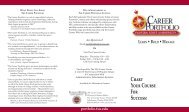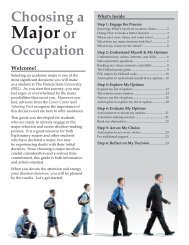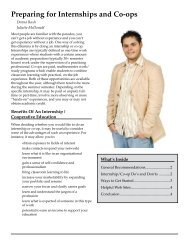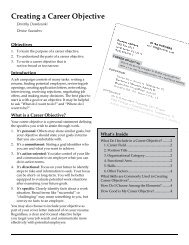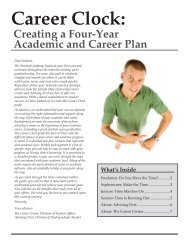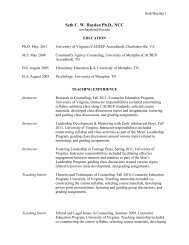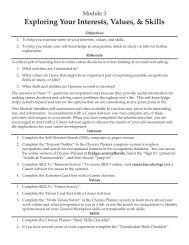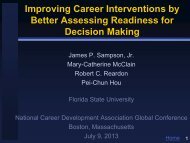Holland's Theory in a Post-Modern World: - The Career Center ...
Holland's Theory in a Post-Modern World: - The Career Center ...
Holland's Theory in a Post-Modern World: - The Career Center ...
You also want an ePaper? Increase the reach of your titles
YUMPU automatically turns print PDFs into web optimized ePapers that Google loves.
Holland’s <strong><strong>The</strong>ory</strong> 8of types is a circumplex. Similar to the circular order hypothesis, the circumplex hypothesisholds the same predictions for the relationships between types but adds that the correlationsbetween each of the adjacent types will be equal, the correlations between each of the alternatetypes will be equal, and the correlations between each of the opposite types will be equal.<strong>The</strong>re have been mixed results regard<strong>in</strong>g support for the circular structure of the RIASECmodel across cultures. Some have proposed alternative models to expla<strong>in</strong> <strong>in</strong>terests that are notaligned with Holland’s theory (Prediger, 1982; Tracey & Rounds, 1995). Rounds and Tracey(1996) used a meta-analysis to exam<strong>in</strong>e the cross cultural applicability of Holland’s hexagonalstructure.Another method for represent<strong>in</strong>g the circumplex model is Prediger’s (1982) twodimensionalschema of vocational <strong>in</strong>terests, which is an additional way to view Holland’sRIASEC hexagon. Prediger asserted that the hexagon is a multidimensional model which can bebetter represented us<strong>in</strong>g two bipolar dimensions. <strong>The</strong> two dimensions are labeled people-th<strong>in</strong>gsand ideas-data.F<strong>in</strong>ally, as an extension of this model, Tracey and Rounds (1995) proposed a thirddimension of vocational <strong>in</strong>terests which they labeled prestige. <strong>The</strong>y suggested that vocational<strong>in</strong>terests are better represented by a sphere rather than a circle and unlike the hexagonal model,types on the spherical model are not of equal distance from their neighbor<strong>in</strong>g types.For example, Liu and Rounds (2003) found <strong>in</strong> ma<strong>in</strong>land Ch<strong>in</strong>a that the distances betweenthe Realistic and Conventional types and Investigative and Artistic types were greater than otherdistances and proposed an octant model. This implies that RIASEC types are located on a circleat po<strong>in</strong>ts <strong>in</strong> an octant model but with two empty spaces on the model, between R and C and alsobetween I and A, for unspecified types.



